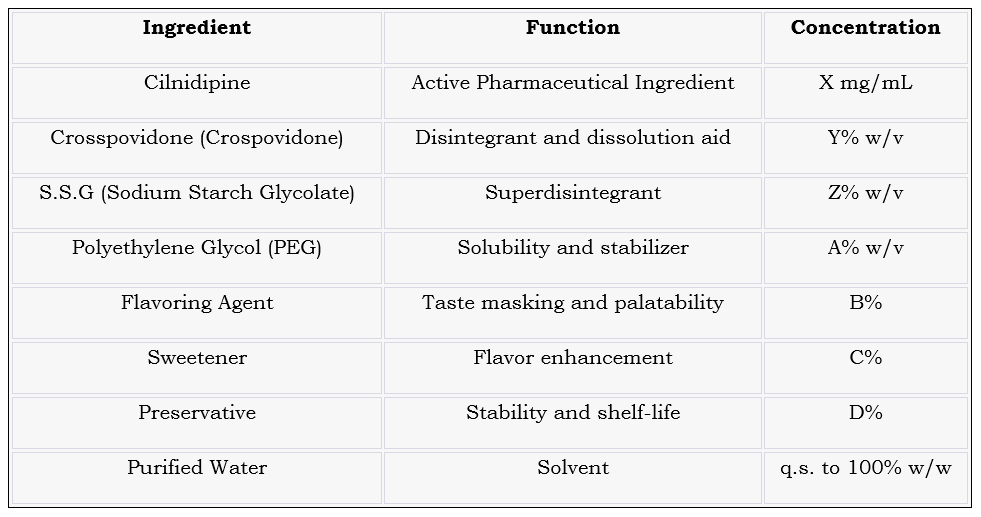Cilnidipine is a medication that belongs to a class of drugs called calcium channel blockers. It is primarily used to treat hypertension (high blood pressure). Cilnidipine works by relaxing and widening the blood vessels, which helps to lower blood pressure. This can reduce the workload on the heart and improve blood flow.
An oral dispersion, in pharmaceutical terms, refers to a formulation of a medication that is in a liquid or semi-liquid form, intended to be taken orally. Oral dispersions are designed to improve the dissolution and absorption of the medication, potentially leading to a faster onset of action and improved bioavailability.
An oral dispersion could be a solution, suspension, or other liquid formulation that contains the active pharmaceutical ingredient (in this case, cilnidipine) along with various excipients (inactive ingredients) to enhance stability, taste, and overall usability.
Cilnidipine Oral Dispersion Formulation with A Polymer

In this hypothetical formulation, crospovidone and S.S.G polymers are included as disintegrants and super disintegrants, respectively, to help the oral dispersion disintegrate rapidly in the gastrointestinal tract, aiding in the drug’s dissolution and absorption. Polyethylene Glycol (PEG) is included for solubility enhancement and stability. Flavoring agents, sweeteners, and a preservative are also part of the formulation to improve taste, palatability, and shelf-life. Purified water serves as the solvent to make up the dispersion’s volume.
Methods Used in Super disintegrants In Oral Dispersion
Superdisintegrants are substances used in pharmaceutical formulations to facilitate the disintegration of tablets, capsules, and other solid dosage forms in the presence of water, promoting rapid drug release and dissolution. Superdisintegrants play a crucial role in oral dispersions by helping the dosage form break down quickly and release the active pharmaceutical ingredient for absorption. Several methods are employed to incorporate super disintegrants into oral dispersion formulations:
Direct Compression: Superdisintegrants can be directly blended with other excipients and the active ingredient to create a dry blend. This blend is then compressed to form tablets using a tablet press. Direct compression is a straightforward and commonly used method for producing tablets containing super disintegrants.
Wet Granulation: In wet granulation, the active ingredient, super disintegrant, and other excipients are mixed together with a wetting agent or binder to form granules. These granules are then dried and compressed into tablets. Wet granulation can enhance the uniform distribution of super disintegrants and other components in the formulation.
Dry Granulation (Slugging): Dry granulation involves compacting the powdered mixture of the active ingredient, super disintegrant, and other excipients into large tablets or slugs using a tablet press. The slugs are then broken down into granules, which can be compressed into tablets. This method is suitable for formulations that are sensitive to moisture.
Melt Granulation: Melt granulation involves melting the super disintegrant along with other excipients, then allowing the mixture to cool and solidify. The solidified mass is then granulated and compressed into tablets. This method can be useful for heat-stable super disintegrants and when moisture needs to be minimized.
Spray-Drying: Superdisintegrant solutions or suspensions can be spray-dried to create dry particles that can be incorporated into oral dispersion formulations. Spray-dried particles can disintegrate more rapidly when exposed to water.
Solid Dispersion: In some cases, super disintegrants can be combined with the active ingredient in a solid dispersion form, where they are dispersed within a carrier material. This can enhance the dissolution rate of poorly water-soluble drugs, leading to improved disintegration.
Common super disintegrants used in oral dispersions include Sodium Starch Glycolate (SSG), Crospovidone (Crospovidone), Croscarmellose Sodium, and Polacrilin Potassium. The choice of method depends on factors such as the properties of the active ingredient, the desired release profile, the formulation’s moisture sensitivity, and manufacturing capabilities.
Polymers used in Cilnidipine
- Hydroxypropyl methylcellulose (HPMC)
- Polyvinyl pyrrolidone (PVP)
- Polyethylene Glycol (PEG)
- Microcrystalline cellulose (MCC)
- Crospovidone
- Sodium Starch Glycolate (S.S.G)
- Kyron T-314
Cilnidipine Oral Dispersion Tablet Uses
Cilnidipine oral dispersion tablets are a specific formulation of cilnidipine, a medication primarily used to treat hypertension (high blood pressure). Cilnidipine belongs to the class of drugs known as calcium channel blockers, which work by relaxing blood vessels, reducing the resistance in arteries, and thereby lowering blood pressure.
The key use of cilnidipine oral dispersion tablets is the same as regular cilnidipine tablets, which is to treat high blood pressure. These tablets are designed to dissolve quickly in the mouth without the need for water, making them convenient for individuals who may have difficulty swallowing traditional tablets or capsules. This can be especially useful for elderly patients or those with swallowing difficulties.
Here are the main indications for cilnidipine oral dispersion tablets:
Hypertension (High Blood Pressure): Cilnidipine oral dispersion tablets are prescribed to lower blood pressure in individuals with hypertension. By blocking calcium channels in the blood vessels, they relax the arteries, reduce resistance, and help lower blood pressure.
Hypertensive Emergency: In some cases of severe hypertension where immediate blood pressure reduction is necessary to prevent organ damage, cilnidipine oral dispersion tablets may be used as part of the treatment strategy.
Cilnidipine oral dispersion tablets offer some advantages over traditional tablets and capsules, which can be particularly beneficial for certain individuals:
Ease of Administration: These tablets are designed to dissolve quickly in the mouth, so they do not require water for swallowing. This can be especially helpful for people who have difficulty swallowing pills or capsules, including elderly individuals, children, or those with certain medical conditions.
Rapid Onset of Action: Cilnidipine oral dispersion tablets can be absorbed into the bloodstream more quickly than traditional tablets or capsules that need to be digested in the stomach. This may result in a faster onset of action, allowing for more rapid blood pressure control.
Convenience: Since no water is needed, these tablets can be taken discreetly and on the go, making them a convenient option for people who may not have access to water at all times.
Reduced Risk of Choking: For individuals with a history of choking on tablets or capsules, oral dispersion tablets can be a safer alternative as they dissolve easily in the mouth.
Improved Medication Adherence: The ease of administration and convenience of these tablets may improve medication adherence, as patients are more likely to take their prescribed dose consistently.
It’s important to note that while cilnidipine oral dispersion tablets offer these advantages, they should still be used under the guidance of a healthcare professional. Dosage and treatment duration will be determined by your healthcare provider based on your specific health needs and response to the medication. Additionally, it’s crucial to report any side effects or concerns to your healthcare provider to ensure safe and effective treatment for high blood pressure.
Make sure you also check our other amazing Article on: Alcohol And Disulfiram
